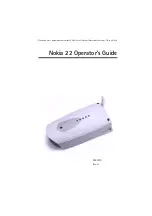
1.16 Caller ID Features
Feature Guide
117
Access (DISA) ring groups, forwarded calls, intercepted calls, or calls from extensions that placed
outside (CO) line calls on consultation hold.
•
SLT Caller ID signalling type can be selected through system programming (
SLT Caller ID Signalling
Type [150]).
•
Each SLT (including an SLT connected in parallel with a PT) can be programmed to receive Caller ID
information through system programming (
SLT Caller ID [628]).
•
When the caller's telephone number is sent to an SLT, an Outside (CO) Line Access number can be
automatically added to the telephone number through system programming (
SLT Caller ID Line
Access Number [151]), to be used when calling the caller back.
•
If a call is transferred, forwarded, or intercepted via Intercept Routing to an SLT, the original caller's
information will be shown on the SLT.
•
During a conversation, Caller ID information will not be shown on the SLT.
•
When FSK-type Caller ID information is received, the caller's telephone number (max. 20 digits), name
(max. 16 characters), date and time, or the reason for nondisplay of Caller ID information such as
"Private", "Out of Area", or "Long Distance" will be shown on the SLT. If the caller's telephone number
exceeds 20 digits, the SLT receives only the first 20 digits. If the caller's name exceeds 16 characters,
the SLT receives only the first 16 characters.
•
When DTMF-type Caller ID information is received, the caller's telephone number (max. 16 digits) or
the reason for nondisplay of Caller ID information will be shown on the SLT. If the caller's telephone
number exceeds 16 digits, the SLT receives only the first 16 digits. However, when a value less than
"1500 ms" is set through system programming (
SLT Ring Bell-on Time [143]), the SLT receives only
the first 10 digits.
•
Depending on the type of SLT being used, caller names and the dates and times that calls were
received may not be able to be shown on the SLT.
•
If an outside caller disconnects a call to an SLT on which the call's Caller ID information is displayed,
and the SLT receives another outside (CO) line call directly after, the SLT will wait until a
preprogrammed time has passed (
SLT Ring Wait Time for New Call [627]) before it starts to ring,
and the new caller's Caller ID information will be shown on the SLT. A certain amount of time may be
required between calls for an SLT to receive Caller ID information correctly.
•
To enable the Caller ID feature, it may be necessary to set the same ring tone pattern (
SLT Fixed
Bell Pattern [629]) as used by the telephone company.
•
When an SLT is programmed to receive Caller ID information, the ringing of calls with Caller ID on that
SLT is delayed for a few seconds. Therefore, the length of time before calls are forwarded or intercepted,
and the length of time that intercepted calls ring at the destination SLT, may be slightly shorter than the
duration specified through system programming.
Installation Manual References
2.3.2 3-Port Caller ID Card (KX-TE82493)
Feature Guide References
1.6.1.5 Speed Dialling—Personal/System
1.20.1 Station Message Detail Recording (SMDR)
4.2.1 Tones/Ring Tones
Summary of Contents for KX-TEB308
Page 13: ...Feature Guide 13 Section 1 Call Handling Features ...
Page 154: ...1 22 Audible Tone Features 154 Feature Guide ...
Page 155: ...Feature Guide 155 Section 2 System Configuration and Administration Features ...
Page 167: ...2 3 System Data Control Feature Guide 167 3 2 PC Programming ...
Page 181: ...Feature Guide 181 Section 3 Programming Instructions ...
Page 252: ...3 3 PT Programming 252 Feature Guide ...
Page 253: ...Feature Guide 253 Section 4 Appendix ...
Page 262: ...4 2 Tones Ring Tones 262 Feature Guide ...
Page 263: ...Feature Guide 263 Index ...
Page 269: ...Index Feature Guide 269 ...













































